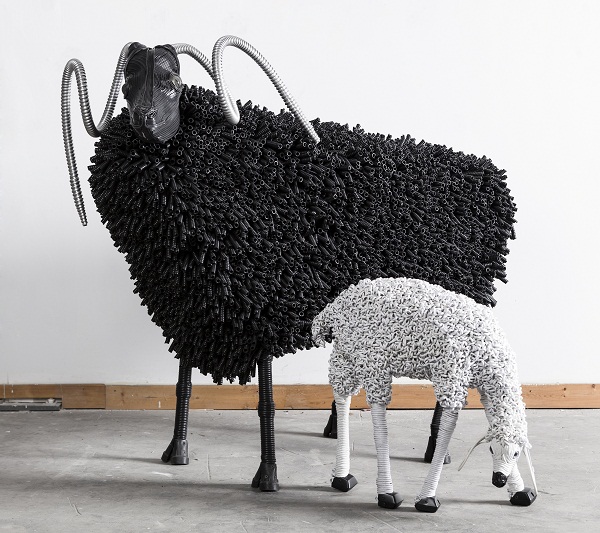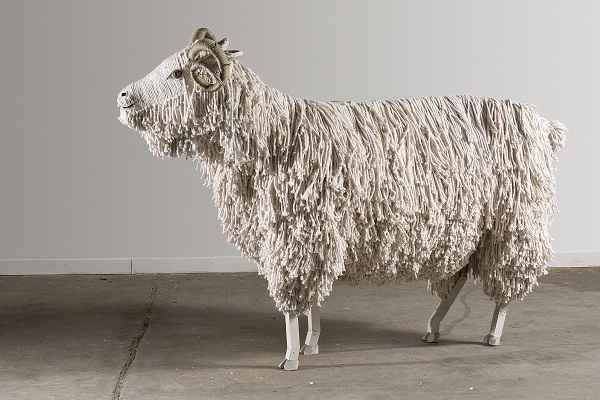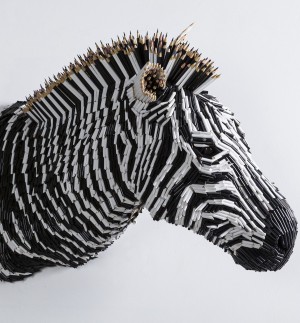Artist of the Week 8/15 – 8/21: Federico Uribe Brings Whimsy and Irony to Everyday Objects
Despite a thick Spanish accent, conceptual artist Federico Uribe transcends language barriers with his life-size sculptures that seem to particularly resonate with the American people. When one thinks of Columbia, the birth place of Uribe, drugs, violence and other stereotypes flood the mind. However, living on a land that is infrequently regarded for its beauty, somewhere on a lush farm, a young Uribe was being subconsciously influenced by the farm animals he was growing up around.
After completing his art studies at the University of Los Andes in Bogota, Uribe left his motherland in the late ’80s and arrived in the art capital of the world: New York. While many young people are often transformed by the American light, in constant search of the American dream, the inner farm boy was incessantly brewing within the young man. It was in New York City that Uribe began his art career as a painter; conflicted by his love for a man and the Catholic view on love, his canvas reflected his dark and sensual relationship with the Church.
After years of picking up a paintbrush and literally painting his reflective views of pain and guilt onto the canvas, manifested largely by Catholic views on such subjects, he abandoned his agony and painting tools, and began meticulously creating unconventional sculptures that made it difficult for him to be classified as just a sculptor. He carved a niche big enough for himself, his work and the still unforeseen artistic pathways he could someday take, and it hasn’t been able to be filled by anyone else.
Since then, Uribe’s intuitive artistic sense has erupted and he has been creating work that is reflective of the simple life — reminiscent of his time on the farm. Consistent with his creation of conventional sculptures, he constructs his often spirited works, among which is an ongoing series entitled Animal Farm, out of ordinary objects such as mops, shoelaces, and wooden strips. Yet, the end results are life-sized replicas of animals so unordinary, texturized and capricious, it’s hard for anyone to look at them without being overcome with awe.
GALO: You began your career as a painter, reflecting on the Catholic sense of pain, guilt and sex, you then transitioned into sculpting. How did the idea to mix elements of agriculture and the manufacturing industry in your Animal Farm series come along?
Federico Uribe: Life changes and we change with it. I painted painfully religious paintings because I felt oppressed by the Catholic Church, their principles and their absurd approach to love and sexuality. Then I met a man I fell in love with and my life changed radically. Soon I started celebrating life and its creatures and I stopped complaining about it. I spent a big part of my childhood on a farm, so I have vivid memories of it and its beauty.

Federico Uribe’s sculptures from his “Animal Farm” series. Photo Courtesy of: Federico Uribe.
GALO: Columbia has been at war for almost half a century and has often been associated with drugs. Is there any political statement to your series or perhaps a subliminal message that you were trying to convey? And is there anything in your past, for instance as a child growing up in Columbia that contributed to you making this type of series?
FU: I don’t send messages through my work. I don’t think that is the purpose of it. I make objects with the purpose of beauty and I want people to have that feeling that we get when we see someone or something beautiful. The whole idea of my work is that you can see and think differently; that there is beauty out there everywhere for you to find and that no matter how hard your reality may be, your mind can give you freedom to read reality in a different way.
GALO: The animals in your series look tremendous in size; they also require some distance in order to see the depths in texture and color. How big is your biggest sculpture in your Animal Farm series and how long did it take to complete?
FU: They’re life size horses, cows, goats, etc. I had one assistant when I made that and it took two years to complete, but it is an ongoing project. Some pieces get sold; the show is moving to different venues around the world and it changes. Every size of the piece that is shown depends on the space. Out of the pieces that have been made, I like the idea of constructing animals and trees and building them from the materials that they were originally made from. I make animals out of shoes, trees out of books, and so on. It’s like giving back; I can’t give them back life, but I can give them the echo of life, which is as much as art can do.

Federico Uribe’s sculptures from his “Animal Farm” series. Photo Courtesy of: Federico Uribe.
GALO: You began seeing the beauty in everyday objects, collecting them and setting them aside. Did you use collected material for your Animal Farm series — what exactly is the process of making your sculptures?
FU: Every object looks like something or the remains of something; it’s like the children’s game of finding shapes in the clouds, I play it all day long. Some of the materials are given to me by companies, others by people, and some of them, I buy on sales or overstock or places that go out of business. Sometimes, I have a very clear idea of what animal to make and what material to use. The material gives me an idea, sometimes, I let the material rest for a while and then, one day, I realize what it looks like. Every object has a sociological, emotional, cultural and personal memory in our mind. Once I understand what it is, then I start working. I don’t do sketches. I work from the image in my head. I’m not trying to reproduce reality, I’m trying to make a self-portrait as an animal.
(Article continued on next page)

